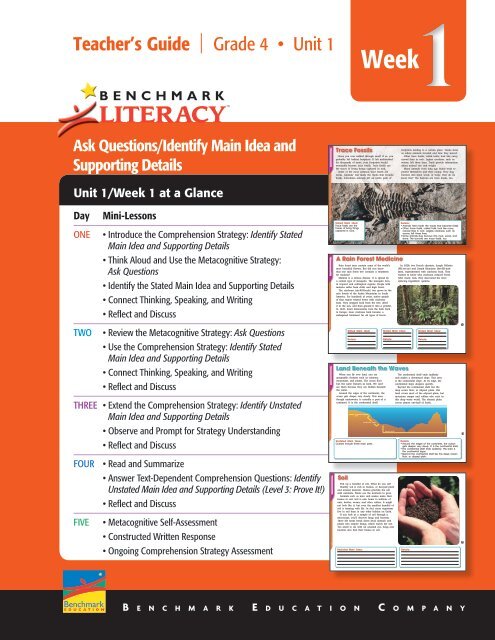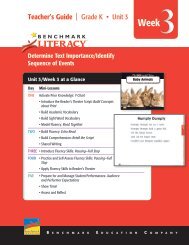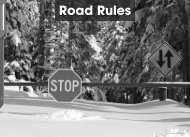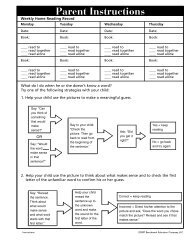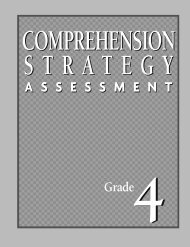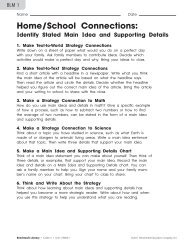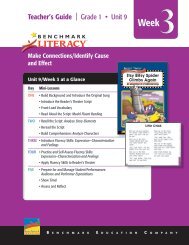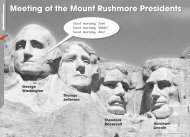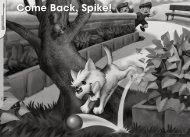Literacy - Benchmark Resources - Benchmark Education Company
Literacy - Benchmark Resources - Benchmark Education Company
Literacy - Benchmark Resources - Benchmark Education Company
- No tags were found...
Create successful ePaper yourself
Turn your PDF publications into a flip-book with our unique Google optimized e-Paper software.
®Bcontinentalshelfcontinental slopeabyssal plainTeacher’s Guide Grade 4 • Unit 11Week<strong>Benchmark</strong><strong>Literacy</strong>TMAsk Questions/Identify Main Idea andSupporting DetailsIdentify Main Idea & Supporting DetailsNonfiction Poster 1Trace FossilsHave you ever walked through mud? If so, youprobably left behind footprints. If left undisturbedfor thousands of years, your footprints wouldeventually become trace fossils. Trace fossils arethe traces of living things captured in rock.Some of the most common trace fossils aretracks. Animals’ feet made the tracks that becamefossils. Sometimes animals left an entire path offootprints leading to a certain place. Tracks showus where animals traveled and how they moved.Other trace fossils, called trails, look like curvy,carved lines in rock. Legless creatures, such asworms, left these lines. Trails provide informationabout animal size and weight.Many animals from long ago found ways toprotect themselves and their young. They dugburrows into mud, wood, or stone. How do weknow this? The burrows are trace fossils, too.Unit 1/Week 1 at a GlanceDayONEMini-Lessons• Introduce the Comprehension Strategy: Identify StatedMain Idea and Supporting Details• Think Aloud and Use the Metacognitive Strategy:Ask Questions• Identify the Stated Main Idea and Supporting Details• Connect Thinking, Speaking, and Writing• Reflect and DiscussGrade 4Identify Main Idea & Supporting DetailsNonfiction Poster 2Stated Main Idea:Details:Trace fossils are the• Animals’ feet made the tracks that became fossils.traces of living things• Other trace fossils, called trails, look like curvy,captured in rock.carved lines in rock. Legless creatures, such asworms, left these lines.• Some animals dug burrows into mud, wood, andstone. The burrows are trace fossils, too.A Rain Forest MedicineRain forest trees contain some of the world’s In 1820, two French chemists, Joseph Pelletiermost beautiful flowers. But did you know(PEL-tee-ay) and Joseph Bienaime (bee-EH-nuhmee),experimented with cinchona bark. Theythat one rain forest tree contains a treatmentfor malaria?wanted to know why cinchona reduced fevers.Malaria is a serious disease. It is spread by After many tests, they discovered the fevera certain type of mosquito. The mosquito lives reducing ingredient: quinine.in tropical and subtropical regions. People withmalaria suffer from chills and high fevers.The cinchona (sin-KOH-nuh) tree grows in therain forests of the Andes Mountains in SouthAmerica. For hundreds of years, native peopleof that region treated fevers with cinchonabark. They stripped bark from the tree, driedit in the sun, and then ground it into a powder.In 1639, Jesuit missionaries took the bark backto Europe. Soon cinchona bark became awidespread treatment for all types of fevers.TWO• Review the Metacognitive Strategy: Ask Questions• Use the Comprehension Strategy: Identify StatedMain Idea and Supporting Details• Connect Thinking, Speaking, and Writing• Reflect and DiscussTHREE • Extend the Comprehension Strategy: Identify UnstatedMain Idea and Supporting Details• Observe and Prompt for Strategy Understanding• Reflect and DiscussFOUR • Read and Summarize• Answer Text-Dependent Comprehension Questions: IdentifyUnstated Main Idea and Supporting Details (Level 3: Prove It!)• Reflect and DiscussFIVE• Metacognitive Self-Assessment• Constructed Written Response• Ongoing Comprehension Strategy AssessmentGrade 4Identify Main Idea & Supporting DetailsNonfiction Poster 3Grade 4Identify Main Idea & Supporting DetailsNonfiction Poster 4Grade 4Land Beneath the WavesWhen you fly over land, you seegeographic features such as canyons,mountains, and plains. The ocean floorhas the same features as land. We can’tsee them because they are hidden beneaththe water.Around the edges of the continents, theocean gets deeper very slowly. This area,though underwater, is actually a part of acontinent. It is the continental shelf.Unstated Main Idea:Oceans include three main parts.SoilStated Main Idea:Details:Pick up a handful of soil. What do you see?Healthy soil is rich in humus, or decayed plantand animal material. Humus provides the soilwith nutrients. Plants use the nutrients to grow.Animals such as mice and snakes make theirhomes in soil. Soil is also home to millions ofants, beetles, worms, and other critters. It mightnot look like it, but even the smallest handful ofsoil is teeming with life. In fact, more organismslive in soil than in any other habitat on Earth.If you look at a sample of soil through amicroscope, you’ll discover fungi and bacteria.These life forms break down dead animals andplants into simpler things, which enrich the soil.Too small to see with an unaided eye, fungi andbacteria also find their homes in soil.Unstated Main Idea:Stated Main Idea:Details:The continental shelf ends suddenlyand makes a downward slope. This areais the continental slope. At its edge, thecontinental slope deepens quickly.Beyond the continental shelf lies thedeep ocean floor, or abyssal plain. Flatland covers most of the abyssal plain, butmountain ranges and valleys also exist inthis deep water world. The abyssal plaincovers almost one-half of Earth.Details:• Around the edges of the continents, the oceangets deeper very slowly. It is the continental shelf.• The continental shelf ends suddenly. This area isthe continental slope.• Beyond the continental shelf lies the deep oceanfloor, or abyssal plain.Details:Stated Main Idea:Details:e n c h m a r k E d u c a t i o n C o m p a n y
Day OneIdentify Main Idea & Supporting DetailsNonfiction Poster 1Trace FossilsHave you ever walked through mud? If so, youprobably left behind footprints. If left undisturbedfor thousands of years, your footprints wouldeventually become trace fossils. Trace fossils arethe traces of living things captured in rock.Some of the most common trace fossils aretracks. Animals’ feet made the tracks that becamefossils. Sometimes animals left an entire path offootprints leading to a certain place. Tracks showus where animals traveled and how they moved.Other trace fossils, called trails, look like curvy,carved lines in rock. Legless creatures, such asworms, left these lines. Trails provide informationabout animal size and weight.Many animals from long ago found ways toprotect themselves and their young. They dugburrows into mud, wood, or stone. How do weknow this? The burrows are trace fossils, too.Read-Aloud (10 minutes)Select a favorite fiction read-aloud from your classroom or school library withwhich to model the metacognitive strategy “Ask Questions.” Use the sampleread-aloud lessons and suggested titles in the <strong>Benchmark</strong> <strong>Literacy</strong> Overview.Grade 4Stated Main Idea:Trace fossils are thetraces of living thingscaptured in rock.Comprehension Anchor Poster 1Lesson ObjectivesDetails:• Animals’ feet made the tracks that became fossils.• Other trace fossils, called trails, look like curvy,carved lines in rock. Legless creatures, such asworms, left these lines.• Some animals dug burrows into mud, wood, andstone. The burrows are trace fossils, too.Students will:• Identify stated main ideas andsupporting details in a text.• Ask questions about a text.• Use academic sentence framesto discuss strategies.Related <strong>Resources</strong>• Whiteboard CD-ROM• Home/School Connections (BLM 1)About the Strategy• A main idea is what a paragraph,article, or story is about.• Sometimes the author states themain idea directly. Other timesreaders use clues (in fiction) orevidence (in nonfiction) to identifythe main idea.Mini-Lessons (20 minutes)Introduce the Comprehension Strategy:Identify Stated Main Idea and Supporting DetailsSay: Snow days are so much fun! Usually, school closes when it snows.I go outside and build a snowman with my friends, and make snow angels.We sled down a huge hill in my neighborhood. But the best part of the dayis when I come back home. My dad makes the best hot cocoa, with realchocolate and huge marshmallows. Snow days are the best days!Ask: What is the most important idea about snow days? What details tell youmore about the important idea?Turn and talk. Ask pairs to share their favorite activity and why they like thatactivity. Then have students provide three details to support their opinions.Ask a few students to share with the whole group.Explain: You just expressed a main idea to your partner and provided detailsthat gave more information about, or supported, the main idea. When youdescribe something or have an opinion, it helps to have information, ordetails, to support your idea or argument. Writers do this, too. Good readersknow how to identify the main idea and supporting details in fiction andnonfiction texts. We’re going to practice identifying the main idea and detailsthis week.Think Aloud and Use the Metacognitive Strategy:Ask QuestionsDisplay Poster 1 with annotations concealed.Draw students’ attention to the title, “Trace Fossils.” Whiteboard users can usethe highlighter tool.Explain: Good readers ask questions before, during, and after they read.Asking questions helps readers understand better, clarify information, andstay interested in the text.2<strong>Benchmark</strong> <strong>Literacy</strong> • Grade 4 • Unit 1/Week 1©2011 <strong>Benchmark</strong> <strong>Education</strong> <strong>Company</strong>, LLC
Day OneI am going to show you how I ask questions about a text. The title of thispassage makes me wonder what this article is about. I can ask a questionabout the title to ensure that I will understand what I’m reading. Let meshow you how I ask questions about a text.Think aloud. Say: The title “Trace Fossils” makes me wonder what this textis about. I can ask a question about the title to ensure that I will understandwhat I’m reading. I know what a fossil is, but what is a trace fossil? Wherecan I find the answer to this question? What does the photo show? Willthe photo help me figure out what a trace fossil is? Asking and answeringthese questions can help me figure out the main idea of this article and thedetails that tell more about that idea.Write your questions on chart paper. Ask students to generate otherquestions they could ask, and add these to your list. Explore possibleanswers together.Post these questions on the wall as an Ask Questions anchor chart, or askstudents to write them in their reading journals.Identify Stated Main Idea and Supporting DetailsRead aloud the poster passage with students.Ask students to state the main idea of the passage in their own words.Ask them to share at least two details to support the main idea. Providethe following academic sentence frames to support ELLs and strugglingstudents:The main idea was .The details that support the main idea are .Reveal the annotations so that students can confirm/revise their ideas.Point out that in this passage, the author directly states the main ideaof each paragraph either in the first or last sentence of the paragraph.Connect Thinking, Speaking, and WritingWrite down the main idea and details students came up with. Reread themas a group. Provide an opportunity for students to expand on their sharedwriting of the main idea and details.Make Content Comprehensiblefor ELLsUse the following strategies to helpELLs understand the poster content andacquire academic language.BeginningPoint to the photograph as you say theword fossil.Use simple sentence frames to discussfossils, for example:This fossil is a(n) .This animal lived long ago.Display actual fossils.Beginning and IntermediateShare the English/Spanish cognate fossil/el fósil.Support Special Needs LearnersSupport visual learners and studentswith attention issues by projecting thewhiteboard version of the posters. Allowstudents to come to the whiteboard andcircle, underline, or highlight the main ideaand details in the text. Invite them to labelwhat they see.Access the graphic organizer providedon the whiteboard version. Record mainideas and details with students.Access the image bank for enlargedimages that students can use to practiceasking questions, determining main ideaand details, and retelling facts.Stated Main Idea:Trace fossils are the traces ofliving things captured in rock.Details:• Animals’ feet made the tracksthat became fossils.• Other trace fossils, called trails,look like curvy, carved lines inrock. Legless creatures, such asworms, left these lines.• Some animals dug burrows intomud, wood, and stone. Theburrows are trace fossils, too.Comprehension Anchor Poster 1Sample Annotations©2011 <strong>Benchmark</strong> <strong>Education</strong> <strong>Company</strong>, LLC <strong>Benchmark</strong> <strong>Literacy</strong> • Grade 4 • Unit 1/Week 1 3
Day OneComprehension Quick-CheckObserve whether students are ableto articulate the main idea and details inthe poster. If necessary, use the followingadditional explicit instruction.Draw a main idea/supporting detailsgraphic organizer on chart paper.In the top box, write Trace fossils are thetraces of living things.Say: This is the main idea. The main ideagives the most important information.In the first Details box, write “Animals’ feetmade tracks that became fossils.”Say: I looked in the text, and I foundexamples of fossils. I use the examplesto support the main idea.Say: Now you find a detail in the text.Home/School ConnectionsOn Day One, distribute copies of Home/School Connections (BLM 1). Each dayduring the week, assign one of the sixhome/school connection activities for thestudents to complete. Ask them to bringtheir completed assignments to class thenext day. Make time at the beginning ofeach day for students to share their ideas.Reflect and DiscussAsk and discuss the following questions:• Why is it important to identify a main idea and supporting details?How does this help you as a reader?• How did asking questions help you understand what you read?• Where did the author put the main ideas in the passage we readtoday? Where were the details for each main idea?Connect and transfer. Say: When you read nonfiction in small group orindependently, remember to ask yourself questions to help you think aboutthe main ideas.Small-Group Reading Instruction (60 minutes)Based on students’ instructional reading levels, select titles that provideopportunities for students to practice identifying stated main ideas anddetails. See the list provided on the Unit at a Glance chart.Use the before-, during-, and after-reading instruction provided in theTeacher’s Guide for each text.Individual Student Conferences (10 minutes)Confer with individual students on their text selections and applicationof strategies. Use the Reading Conference Note-Taking Form to help guideyour conferences.BLM 1NameDateHome/School Connections:Identify Main Idea and Supporting Details1. Make Text-to-World Strategy ConnectionsWhat is your favorite activity to do at home with your family? Write itdown on a sheet of paper. With help from your family, list the detailsinvolved in doing that activity under the title of the activity. Discuss why itis your favorite activity. Bring your ideas to school to share with your class.2. Make Text-to-Text Strategy ConnectionsFind one or more examples of a headline in a newspaper or magazinethat states a main idea. Then highlight or circle details in the article thatsupport the main idea. Bring your example(s) to school to share withthe class.Word Study Workshop (20 minutes)Use the Day 1 instruction provided in Word Study Skill Bag 1.3. Make a Strategy Connection to MathHow do you use main ideas and details in math? Give a specific exampleof how understanding a major concept, such as multiplication or findingpercentages, can be used in many different circumstances.4. Make a Strategy Connection to ScienceThink about a topic you are studying in science. Write a main ideasentence on that topic. Then write three details that support yourmain idea.5. Make a Main Idea and Supporting Details ChartThink of a main idea that tells about your family. Think of three details, orexamples, to support your main idea. Record your main idea and detailson a Main Idea and Supporting Details chart. You can ask a familymember to help you. Sign your name and your family member’s name toyour chart. Bring your chart to class to share.6. Think and Write About the StrategyThink about how learning about main idea and supporting details hashelped you become a more strategic reader. Write about how and whenyou use this strategy to help you understand what you are reading.<strong>Benchmark</strong> <strong>Literacy</strong> • Grade 4 • Unit 1/Week 1©2010 <strong>Benchmark</strong> <strong>Education</strong> <strong>Company</strong>, LLCHome/School Connections (BLM 1)4<strong>Benchmark</strong> <strong>Literacy</strong> • Grade 4 • Unit 1/Week 1©2011 <strong>Benchmark</strong> <strong>Education</strong> <strong>Company</strong>, LLC
Day TwoRead-Aloud (10 minutes)Select a favorite fiction read-aloud from your classroom or school library withwhich to model the metacognitive strategy “Ask Questions.” Use the sampleread-aloud lessons and suggested titles in the <strong>Benchmark</strong> <strong>Literacy</strong> Overview.Identify Main Idea & Supporting DetailsNonfiction Poster 2A Rain Forest MedicineRain forest trees contain some of the world’s In 1820, two French chemists, Joseph Pelletiermost beautiful flowers. But did you know(PEL-tee-ay) and Joseph Bienaime (bee-EH-nuhmee),experimented with cinchona bark. Theythat one rain forest tree contains a treatmentfor malaria?wanted to know why cinchona reduced fevers.Malaria is a serious disease. It is spread by After many tests, they discovered the fevera certain type of mosquito. The mosquito lives reducing ingredient: quinine.in tropical and subtropical regions. People withmalaria suffer from chills and high fevers.The cinchona (sin-KOH-nuh) tree grows in therain forests of the Andes Mountains in SouthAmerica. For hundreds of years, native peopleof that region treated fevers with cinchonabark. They stripped bark from the tree, driedit in the sun, and then ground it into a powder.In 1639, Jesuit missionaries took the bark backto Europe. Soon cinchona bark became awidespread treatment for all types of fevers.Mini-Lessons (20 minutes)Review the Metacognitive Strategy: Ask QuestionsDisplay Poster 2 and/or distribute BLM 2.Read aloud the text with students.Explain: Yesterday I read the passage about trace fossils and asked myselfquestions to help me understand the passage. Let’s practice asking questionsagain today.Read aloud paragraph 1. Think aloud: In the first paragraph, I read that acertain kind of rain forest tree can treat malaria. What is malaria? How can atree treat malaria? I will look for answers to these two questions as I read on.Write the questions on chart paper.Read aloud paragraphs 2 and 3.Think aloud: The first sentence in paragraph 2 answers my question aboutmalaria. It also provides details about how malaria is spread. The thirdparagraph answers my question about how a tree can treat malaria.Grade 4Stated Main Idea:Details:Stated Main Idea:Details:Comprehension Anchor Poster 2 (BLM 2)Lesson ObjectivesStated Main Idea:Details:Students will:• Ask questions about a text.• Identify stated main ideas andsupporting details in a text.• Use academic sentence framesto discuss strategies.Related <strong>Resources</strong>• Whiteboard CD-ROM• Home/School Connections (BLM 1)• Comprehension Anchor Poster 2(BLM 2)On the chart paper, write these answers next to each question.Ask students to generate other questions. Add their questions to the list on thechart paper. Post this Ask Questions anchor chart on the wall, or have studentswrite the questions in their reading journals to use in the future. ©2011 <strong>Benchmark</strong> <strong>Education</strong> <strong>Company</strong>, LLC <strong>Benchmark</strong> <strong>Literacy</strong> • Grade 4 • Unit 1/Week 1 5
Day TwoParagraph 1: Stated Main Idea:Malaria is a serious disease.Detail:People with malaria suffer fromchills and high fevers.Paragraph 2: Stated Main Idea:For hundreds of years, nativepeople treated fevers withcinchona bark.Details:• The cinchona tree grows inthe rain forests of the AndesMountains in South America.• They stripped the bark fromthe tree, dried it in the sun, andground it into a powder.Paragraph 3: Stated Main Idea:They wanted to know whycinchona reduced fevers.Details:• In 1820, two French chemists,Joseph Pelletier and JosephBienaime, experimented oncinchona bark.• They discovered the feverreducingingredient: quinine.Comprehension Anchor Poster 2Sample AnnotationsHome/School ConnectionsAt the beginning of the day, make time forstudents to share their ideas based on theactivity they completed the previous night.At the end of the day, ask students tocomplete another home/school connectionactivity from BLM 1 and to bring theirassignment to class the following day.Build academic oral language. Read the last paragraph. Encourage studentsto ask themselves about the main idea of the final paragraph, and to ask whatdetails support that idea. Point out that the main idea is not always the firstsentence in a paragraph. Have students describe how asking questions helpedthem identify the main idea and details in this paragraph. Reinforce the ideathat good readers ask questions to understand text better. Support ELLs andstruggling readers with the following sentence frames:The main idea is .The supporting details are .Asking questions helped me .Use the Comprehension Strategy:Identify Stated Main Idea and Supporting DetailsReread the poster text with students.Say: Now think about the content of this passage. What was it mostly about?If necessary, explain that the passage is mostly about a treatment for malariathat comes from a rain forest tree. To describe the disease and the treatment,the author states a few main ideas and supporting details for each main idea.Remind students that the main idea is not always the first sentenceof a paragraph.Say: Let’s look closely at the text and find each stated main idea.Write the main ideas that students identify in the prompt boxes.Build academic oral language. Say: Sometimes details support a main ideaby giving examples. Other times, they tell more about the main idea. Authorsprovide details to help readers understand a main idea. What details help youunderstand how serious malaria is? (chills, high fevers)Connect Thinking, Speaking, and WritingPrompt students to identify other details. Remind them that sometimes detailsare examples of the main idea.Record students’ responses in the Details boxes.6<strong>Benchmark</strong> <strong>Literacy</strong> • Grade 4 • Unit 1/Week 1©2011 <strong>Benchmark</strong> <strong>Education</strong> <strong>Company</strong>, LLC
Day TwoReflect and DiscussAsk and discuss the following questions:• What does it mean to ask questions about a text? How does it helpyou as a reader?• How does identifying details help you recognize a main idea?Connect and transfer. Ask: How will you use what we have practicedtoday when you read on your own?Small-Group Reading Instruction (60 minutes)Based on students’ instructional reading levels, select titles that provideopportunities for students to practice identifying stated main idea andsupporting details. See the list provided on the Unit at a Glance chart.Use the before-, during-, and after-reading instruction provided in theTeacher’s Guide for each text.Individual Student Conferences (10 minutes)Confer with individual students on their text selections and applicationof strategies. Use the Reading Conference Note-Taking Form to help guideyour conferences.Word Study Workshop (20 minutes)Use the Day 2 instruction provided in Word Study Skill Bag 1.Make Content Comprehensiblefor ELLsUse the following strategies to helpELLs understand the poster content andacquire academic language.BeginningPoint to and name objects in thephotograph, such as tree, leaves, rainforest. Ask students to say the nameswith you.Beginning and IntermediateDisplay a map of the Andes mountains.Say: This photo shows a rain forest. Thisrain forest is in the Andes mountains. TheAndes mountains are in South America.All LevelsIf appropriate, share English/Spanishcognates fever/la fiebre, malaria/lamalaria.Pair ELLs with fluent English speakersduring partner discussions and activities.Model the use of academic sentenceframes to support ELLs’ academicvocabulary and language development.(See suggested sentence frames provided.)Oral Language ExtensionDuring independent workstation time, pairstudents to construct oral main ideas andsupporting details related to any topicsthey have studied in class. Partner A statesa main idea. Partner B provides at leastthree details to support the main idea.If necessary, Partner A assists. Then thepartners switch roles. Tell students to charttheir main ideas and details on a graphicorganizer to show you during independentstudent conference time.©2011 <strong>Benchmark</strong> <strong>Education</strong> <strong>Company</strong>, LLC <strong>Benchmark</strong> <strong>Literacy</strong> • Grade 4 • Unit 1/Week 1 7
continentalshelfcontinental slopeabyssal plainDay ThreeIdentify Main Idea & Supporting DetailsNonfiction Poster 3Land Beneath the WavesWhen you fly over land, you seeThe continental shelf ends suddenlygeographic features such as canyons,and makes a downward slope. This areamountains, and plains. The ocean flooris the continental slope. At its edge, thehas the same features as land. We can’tcontinental slope deepens quickly.see them because they are hidden beneathBeyond the continental shelf lies thethe water.deep ocean floor, or abyssal plain. FlatAround the edges of the continents, the land covers most of the abyssal plain, butocean gets deeper very slowly. This area,mountain ranges and valleys also exist inthough underwater, is actually a part of a this deep water world. The abyssal plaincontinent. It is the continental shelf.covers almost one-half of Earth.Read-Aloud (10 minutes)Select a favorite nonfiction read-aloud from your classroom or school librarywith which to model the metacognitive strategy “Ask Questions.” Use thesample read-aloud lessons and suggested titles in the <strong>Benchmark</strong> <strong>Literacy</strong>Overview.Grade 4Unstated Main Idea:Oceans include three main parts.Comprehension Anchor Poster 3 (BLM 3)Lesson ObjectivesDetails:• Around the edges of the continents, the oceangets deeper very slowly. It is the continental shelf.• The continental shelf ends suddenly. This area isthe continental slope.• Beyond the continental shelf lies the deep oceanfloor, or abyssal plain.Students will:• Identify unstated main ideas andtheir supporting details in a text.• Ask questions about a text.• Use academic sentence framesto discuss strategies.Related <strong>Resources</strong>• Whiteboard CD-ROM• Home/School Connections (BLM 1)• Comprehension Anchor Poster 3(BLM 3)Unstated Main Idea:Oceans include three main parts.Details:• Around the edges of thecontinents, the ocean getsdeeper very slowly. It is thecontinental shelf.• The continental shelf endssuddenly. This area is thecontinental slope.• Beyond the continental shelflies the deep ocean floor, orabyssal plain.Comprehension Anchor Poster 3Sample AnnotationsMini-Lessons (20 minutes)Extend the Comprehension Strategy:Identify Unstated Main Idea and Supporting DetailsDisplay Poster 3 with annotations concealed, and/or distribute BLM 3.Say: Sometimes authors do not directly state a main idea in the text.To identify the main idea, readers identify the details, and use thosedetails as clues to figure out the main idea. Today we’re going to practiceidentifying an unstated main idea using details. Remember that we can askourselves questions to help us.Read aloud the first paragraph, and have students identify details. Record theirresponses on chart paper. Repeat with each paragraph. Remind them thatdetails are clues to the unstated main idea of a text. Now reveal the Detailsannotations. Ask: Did we find all the details? Let’s compare lists.Activate metacognitive strategies. Model how to ask questions about thedetails and how to think about the details to figure out the unstated main idea.Ask: What is the land in the ocean like? What are the three partsof the ocean?Record students’ responses on chart paper. Say: Using the details weidentified, we can figure out the main idea of this passage. What do youthink is the main idea? Record students’ ideas on chart paper. Then reveal theUnstated Main Idea annotation. Say: Let’s compare our main idea to the oneon the poster.While using the poster, note students who demonstrate understandingof the concepts and those who seem to struggle. Use appropriate responsiveprompting to help students who need modeling or additional guidance, or tovalidate students who demonstrate mastery.Connect and transfer. Remember that each nonfiction text you read hasa main idea and details. You can use what you have learned to help youfind the main ideas. This will help you when you understand what you readfor science and social studies, too.8<strong>Benchmark</strong> <strong>Literacy</strong> • Grade 4 • Unit 1/Week 1©2011 <strong>Benchmark</strong> <strong>Education</strong> <strong>Company</strong>, LLC
Day ThreeObserve and Prompt for Strategy UnderstandingAs students work together, observe those who demonstrate understandingand those who struggle. Use appropriate responsive prompting to provideadditional support or to validate students who demonstrate mastery.Goal Oriented• To find the main idea, I will think about what the details have in common.• The following details support the main idea that .Directive and Corrective Feedback• Read the passage. Which details are important? How can you tell?• What is the connection between the important details?• What do the details tell you about the main idea?Self-Monitoring and Reflection• What could you do to help yourself use the details to identify the main idea?• What questions could you ask yourself? What did you already know?Validating and Confirming• You really understand what the main idea is based on the details.• I like the way you thought about what you already know to help youunderstand what you read. Great job!• I like the way you asked yourself questions to clarify your understanding.Reflect and DiscussAsk and discuss the following questions:• What kinds of texts have you read that include a main idea and details?• Does a newspaper article have a main idea and details? How doesidentifying the main idea and details in an article help you understand it?• Why is it important to understand the main idea and details?Small-Group Reading Instruction (60 minutes)Continue small-group reading instruction from the previous day.Help students identify the unstated main idea and details in the text they haveread.Individual Student Conferences (10 minutes)Confer with individual students on their text selections and application ofstrategies. Use the Reading Conference Note-Taking Form to help guide yourconferences.Word Study Workshop (20 minutes)Use the Day 3 instruction provided in Word Study Skill Bag 1.Make Content Comprehensiblefor ELLsUse the following strategies to helpELLs understand the poster content andacquire academic language.BeginningDisplay a photo of the ocean, or point toan ocean on a map, and name it.Point to the water on the poster andname it as an ocean. Read the labels onthe poster. Use each label in meaningfulsentences. Point to the floor. Say: This isthe floor. The ocean has a floor, too.IntermediateAsk students to point to the continentalshelf, slope, and abyssal plain as they usethese words in complete sentences.All LevelsIf appropriate, share English/Spanishcognates, such as mountain/la montaña,ocean/el océano, continent/el continente.Pair ELLs with fluent English speakersduring partner discussions and activities.Comprehension Quick-CheckThe responsive prompts on pages 8–9are designed to help you meet the needsof individual students. Based on yourobservations, identify students who mayneed additional explicit reinforcementof the strategy during small-groupinstruction or intervention time. Use similarresponsive prompts during small-groupinstruction to scaffold students towardindependent use of the strategy.Home/School ConnectionsAt the beginning of the day, make time forstudents to share their ideas based on theactivity they completed the previous night.At the end of the day, ask students tocomplete another home/school connectionactivity from BLM 1 and to bring theirassignment to class tomorrow.©2011 <strong>Benchmark</strong> <strong>Education</strong> <strong>Company</strong>, LLC <strong>Benchmark</strong> <strong>Literacy</strong> • Grade 4 • Unit 1/Week 1 9
Day FourIdentify Main Idea & Supporting DetailsNonfiction Poster 4SoilPick up a handful of soil. What do you see?Healthy soil is rich in humus, or decayed plantand animal material. Humus provides the soilwith nutrients. Plants use the nutrients to grow.Animals such as mice and snakes make theirhomes in soil. Soil is also home to millions ofants, beetles, worms, and other critters. It mightnot look like it, but even the smallest handful ofsoil is teeming with life. In fact, more organismslive in soil than in any other habitat on Earth.If you look at a sample of soil through amicroscope, you’ll discover fungi and bacteria.These life forms break down dead animals andplants into simpler things, which enrich the soil.Too small to see with an unaided eye, fungi andbacteria also find their homes in soil.Read-Aloud (10 minutes)Select a favorite fiction read-aloud from your classroom or school library withwhich to model the metacognitive strategy “Ask Questions.” Use the sampleread-aloud lessons and suggested titles in the <strong>Benchmark</strong> <strong>Literacy</strong> Overview.Unstated Main Idea:Details:Comprehension Anchor Poster 4 (BLM 4)Lesson ObjectivesStudents will:• Learn strategies for analyzingquestions and for finding answers,clues, or evidence in a text.• Identify main ideas and theirsupporting details in a text.• Answer text-dependent questionsabout the main idea and supportingdetails.• Use academic vocabulary to discussstrategies.Related <strong>Resources</strong>• Whiteboard CD-ROM• Home/School Connections (BLM 1)• Comprehension Anchor Poster 4(BLM 4)• Comprehension Questions (BLM 5)Mini-Lessons (20 minutes)Read and SummarizeDisplay Poster 4 and/or distribute BLM 4.Based on your students’ needs and abilities, read aloud the passage,or have students read independently or with a partner. Remind studentsto ask questions to help them understand what they read.Build academic oral language. When students have finished, ask individualsor partners to tell what the passage was mostly about. Encourage ELLs orstruggling readers to use the academic sentence frame:This passage was mostly about .Answer Text-Dependent Comprehension Questions: IdentifyUnstated Main Idea and Supporting Details (Level 3: Prove It!)Say: Sometimes you need to answer questions about a passage you’ve read.And some questions require you to identify an unstated main idea. Todaywe’re going to read and answer questions about unstated main ideas.Distribute BLM 5 and read Question 1 together. (“Why do plants need soil togrow?”) Ask: What is the question asking us to do? Is it asking us to identifya sequence of events? Is it asking us to compare? What strategy willwe need to use? (identify unstated main idea)Ask: Let’s think about how the words in the question can help us find theanswer. We need to look at the question very closely. What words will helpus? (plants, soil, grow)Grade 4Say: Now we’re ready to reread the paragraph to find the information weneed. We need to find out what the details in the text tell us about soil, andwhat is in soil that plants need in order to grow. I see the words plants and soilin the first paragraph. The text says that humus provides soil with nutrients. Italso says that plants use nutrients to grow. These details help me understandthat plants need soil because soil contains the nutrients plants need to grow.The exact answer was not in the text, but like a detective, I used evidence tofigure out this unstated main idea. The answer makes sense. So I’ll choose A.10<strong>Benchmark</strong> <strong>Literacy</strong> • Grade 4 • Unit 1/Week 1©2011 <strong>Benchmark</strong> <strong>Education</strong> <strong>Company</strong>, LLC
Day FourHave students work independently or with a partner to answer additionaltext-dependent questions on BLM 5.Review students’ answers and use the poster as needed to model analyzingquestions and rereading to find answers in the text.BLM 5Name<strong>Benchmark</strong> <strong>Literacy</strong> • Grade 4 • Unit 1/Week 1Comprehension Questions (BLM 5)DateSoil: Comprehension Questions1. Why do plants need soil to grow?A Soil has nutrients and plants need nutrients to grow.B Soil is home to millions of ants, beetles, and worms.C Soil is warm.D Soil has bacteria and plants need bacteria to grow.2. Which detail supports the main idea that soil is home toliving things?ABMice and snakes make their homes in soil.More organisms live in soil than in any other habitat on Earth.C Soil is home to millions of ants, beetles, worms, and otherDcritters.All of the above3. You can see fungi and bacteria through a microscope.What unstated main idea does this detail support?A Fungi and bacteria are life forms.B Fungi and bacteria are tiny.C Fungi and bacteria live in soil.D Fungi and bacteria break down dead animals and plants.4. Which detail supports the unstated main idea that fungi andbacteria are important to keep soil healthy?ABFungi and bacteria are too small to see with an unaided eye.Fungi and bacteria are in soil.C Fungi and bacteria break down dead animals and plantsinto simpler things that enrich the soil.None of the aboveD©2010 <strong>Benchmark</strong> <strong>Education</strong> <strong>Company</strong>, LLCStated Main Idea:Soil contains living things: somethings we can see and somethings we can’t see.Details:• Healthy soil is rich in humus,which is decayed plant andanimal material.• Animals such as mice andsnakes make their homes insoil.• Soil is also home to millionsof ants, beetles, worms, andother critters.• More organisms live in soil thanin any other habitat on Earth.• Too small to see with anunaided eye, fungi andbacteria also find their homesin soil.Comprehension Anchor Poster 4Sample AnnotationsMake Content Comprehensiblefor ELLsUse the following strategies to helpELLs understand the poster content andacquire academic language.BeginningPoint to the soil in the photograph andname it. Cup your hands as in the photo asyou say the word handful.Beginning and IntermediateUse the Comprehension StrategyAssessment as a listening comprehensionassessment and scaffold students’understanding of the text. As analternative, allow students to tell you aboutthe main idea and supporting details inone of the Comprehension Anchor Postersyou have used during the week.All LevelsPair ELLs with fluent English speakersduring partner discussions and activities.©2011 <strong>Benchmark</strong> <strong>Education</strong> <strong>Company</strong>, LLC <strong>Benchmark</strong> <strong>Literacy</strong> • Grade 4 • Unit 1/Week 1 11
Day FourComprehension Quick-CheckNote whether students are able toanalyze each Level 3 text-dependentcomprehension question and return to thetext to find the information they need toanswer the question correctly. If studentshave difficulty, use small-group readingtime for additional practice answeringthese kinds of questions, which appearon standardized reading assessments.The Comprehension Question Cardfor each leveled text provides practicequestions at four levels of comprehension.The Comprehension Teacher Flip Charthelps you model the strategies studentsneed to master.Home/School ConnectionsAt the beginning of the day, make time forstudents to share their ideas based on theactivity they completed the previous night.At the end of the day, ask students tocomplete another home/school connectionactivity from BLM 1 and to bring theirassignment to class the following day.Oral Language ExtensionDisplay Comprehension Anchor Poster 4during independent workstation time.Invite pairs of students to read and talkabout the poster together. Encouragestudents to share details about soil—what itlooks like and why it is important. Remindstudents to be prepared to share theirdetails during independent conferencetime.Reflect and Discuss the Comprehension StrategyAsk and discuss the following:• What strategy did we use to answer questions about the text?• Notice how we looked for details to understand and answer questions.Connect and transfer. Say: Practice using these strategies. They can helpyou answer questions in all your subjects. They can also help you when youtake tests.Small-Group Reading Instruction (60 minutes)Based on students’ instructional reading levels, select titles that provideopportunities for students to practice identifying stated main ideas and details.See the list provided on the Unit at a Glance chart.Use the before-, during-, and after-reading instruction provided in theTeacher’s Guide for each text.Use the Comprehension Question Card for each title and the ComprehensionTeacher Flip Chart to practice answering Level 3 text-dependentcomprehension questions.Individual Student Conferences (10 minutes)Confer with individual students on their text selections and applicationof strategies. Use the Reading Conference Note-Taking Form to help guideyour conferences.Word Study Workshop (20 minutes)Use the Day 4 instruction provided in Word Study Skill Bag 1.12<strong>Benchmark</strong> <strong>Literacy</strong> • Grade 4 • Unit 1/Week 1©2011 <strong>Benchmark</strong> <strong>Education</strong> <strong>Company</strong>, LLC
Day FiveRead-Aloud (10 minutes)Revisit the week’s read-alouds to make text-to-text connections andprovide opportunities for reader response. Use the suggested activitiesin the <strong>Benchmark</strong> <strong>Literacy</strong> Overview, or implement ideas of your own.BLM 6NameDateConstructed Written Response:Main Idea and DetailsDetailDetailMain IdeaMini-Lessons (20 minutes)Metacognitive Self-AssessmentDetailDetailAsk students to reflect on their use of metacognitive and comprehensionstrategies this week. What did they learn? How will they use the strategies inthe future? What do they still need to practice, and how can they do this?Have students share their reflections in one of the following ways: conduct awhole-class discussion; have students turn and talk to a neighbor and thenshare their ideas with the class; or ask students to record their thoughts in theirreading journals or notebooks.Constructed Written ResponseDistribute copies of Constructed Written Response (BLM 6) and ask studentsto state a main idea on a subject they are very familiar with, such as a sport orhobby. Then have students list three details to support their main ideas.Ask students to write a paragraph based on their main idea and details.All the details should support the most important point of the paragraphto help readers identify main idea.Ask students to use the checklist at the bottom of BLM 6 to evaluate their work.Challenge activity. Students who are able to may choose to write theirparagraph without directly stating a main idea, but they must include detailsthat will help a reader figure out the unstated main idea.Main Idea and Details Writing ChecklistI included a main idea.I included three details that tell more about the main idea.All of my details are about the main idea.<strong>Benchmark</strong> <strong>Literacy</strong> • Grade 4 • Unit 1/Week 1Constructed Written Response (BLM 6)Lesson Objectives©2010 <strong>Benchmark</strong> <strong>Education</strong> <strong>Company</strong>, LLCStudents will:• Reflect orally on their strategy use.• Create a main idea and supportingdetails graphic organizer and writea paragraph based on it.• Answer multiple-choice andshort-answer questions.Related <strong>Resources</strong>• Whiteboard CD-ROM• Home/School Connections (BLM 1)• Constructed Written Response(BLM 6)• Comprehension StrategyAssessments, Grade 4©2011 <strong>Benchmark</strong> <strong>Education</strong> <strong>Company</strong>, LLC <strong>Benchmark</strong> <strong>Literacy</strong> • Grade 4 • Unit 1/Week 1 13
Day FiveMake Assessments Accessible for ELLsUse the following strategies to help ELLsdemonstrate their understanding of thestrategies.BeginningWork with beginning ELLs to completeMain Idea and Details Constructed WrittenResponse (BLM 6). Allow ELLs to drawtheir ideas.Beginning and IntermediateUse the Comprehension StrategyAssessment as a listening comprehensionassessment and scaffold students’understanding of the text. As analternative, allow students to tell you aboutthe main idea and supporting details inone of the Comprehension Anchor Postersyou have used during the week.Intermediate and AdvancedSupport ELLs with academic sentenceframes during the metacognitive selfassessment.Possible sentence frames touse are:We ask questions so that .I will look for main ideas whenI .All LevelsPair ELLs with fluent English speakersduring partner discussions and activities.Home/School ConnectionsAt the beginning of the day, make time forstudents to share their ideas based on theactivity they completed the previous night.Ongoing Comprehension Strategy AssessmentDistribute one of the Main Idea and Supporting Details Comprehension StrategyAssessment from the Grade 4 Comprehension Strategy Assessment book (“TheLost Colony,” pages 70–71, or “A New Kind of Studio,” pages 72–73). Askstudents to read the passage and use the information to answer the questions.Use the results of this assessment to identify which students need additionalwork with the strategy.Record students’ assessment scores on the Strategy Assessment Record(page 141) so that you can monitor their progress following additionalinstruction or intervention.Provide additional modeling and guided practice during small-group readinginstruction using the titles recommended in this guide.Small-Group Reading Instruction (60 minutes)Based on students’ instructional reading levels, select titles that provideopportunities for students to practice making inferences. See the list providedon the Unit at a Glance chart.Use the before-, during-, and after-reading instruction provided in theTeacher’s Guide for each text.Individual Student Conferences (10 minutes)Confer with individual students on their text selections and application ofstrategies. Use the Reading Conference Note-Taking Form to help guide yourconferences.Word Study Workshop (20 minutes)Use the Day 5 instruction provided in Word Study Skill Bag 1.14<strong>Benchmark</strong> <strong>Literacy</strong> • Grade 4 • Unit 1/Week 1©2011 <strong>Benchmark</strong> <strong>Education</strong> <strong>Company</strong>, LLC


